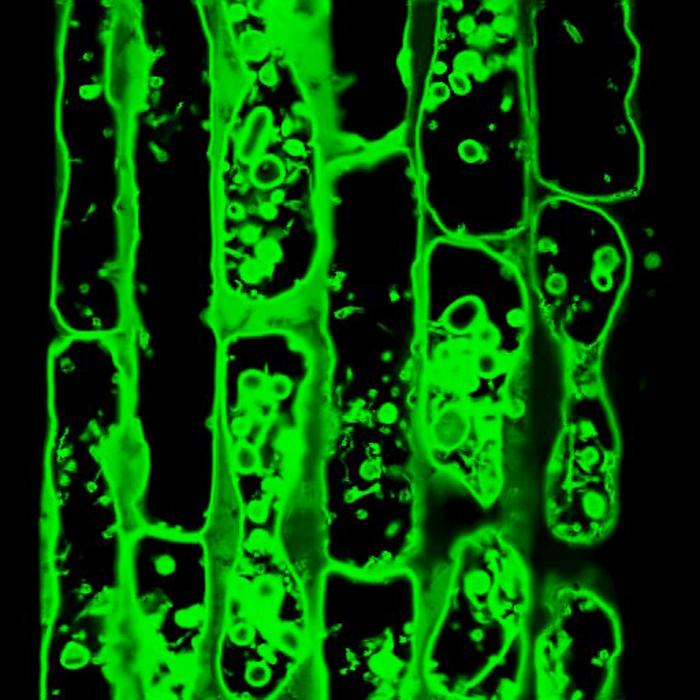
Plants exhibit remarkable resilience, showcasing their ability to respond dynamically to environmental stressors. One particularly captivating phenomenon is how plants, when deprived of water, droop and shed leaves, only to regain their turgor pressure and vitality with a splash of water. This rapid transformation not only underscores the importance of hydration but also highlights the intricate cellular mechanisms that contribute to plant rigidity and structure. At the core of this phenomenon lies a sophisticated interplay between the plant cell’s vacuole, its cell wall, and the cellular components that facilitate structural integrity.
The vacuole, an essential cellular structure, acts much like a water balloon, providing the internal pressure required for maintaining cell shape and rigidity. This internal pressure, combined with the flexible yet strong plant cell wall, forms a delicate balance of forces that allows plants to grow upright without collapsing under their own weight. However, this equilibrium can be disrupted by mechanical damage to the cell wall, leading to potential cell death if not swiftly addressed.
Understanding the consequences of cell wall damage is crucial, as it can result in the vacuole rupturing due to the loss of structural support. The release of vacuolar contents into the cytoplasm can have lethal consequences for the plant cell. While much is known about the repair mechanisms that address cell wall breaches, the protective strategies that prevent vacuole rupture during sudden changes in pressure remain less understood.
Recent research led by the Dagdas team has sought to illuminate this critical gap in knowledge. By employing genetic and functional analyses of two model organisms, Marchantia polymorpha and Arabidopsis thaliana, the researchers have uncovered a conserved quality control mechanism that is integral to the plant’s response to cell wall damage. Central to their findings is the role of a molecule known as ATG8, which undergoes a process called ATG8ylation in response to cell wall breaches.
ATG8 is a member of a protein family involved in autophagy, a cellular degradation pathway that recycles damaged organelles and proteins. In the presence of cell wall damage, ATG8 is rapidly redirected from small vesicles to the vacuolar membrane, where it plays a decisive role in maintaining vacuolar integrity. This relocation is not merely a byproduct of cellular stress; rather, it is a tightly regulated response that indicates the plant’s ability to mobilize protective mechanisms in the face of adverse conditions.
Interestingly, the research demonstrates that any disruption to this pathway hampers the relocation of ATG8 to the vacuole membrane. Such alterations lead to compromised vacuole integrity and subsequent cell death, underscoring the importance of ATG8 in safeguarding the vacuole during cellular stress events. The direct correlation between ATG8ylation and vacuolar stability offers exciting new avenues for investigating how plants monitor and respond to physical damage.
As the Dagdas team delves deeper into their findings, they aim to elucidate the sensory mechanisms that enable plant cells to detect damage to the cell wall. By understanding the signal transduction pathways involved, researchers hope to uncover how the ATG8 conjugation process actively contributes to preserving vacuolar integrity. This inquiry into the protective capabilities of ATG8 could pave the way for enhanced resilience in crops, particularly in the face of challenging environmental conditions such as drought or mechanical injury.
In addition to exploring the plant’s immediate responses to damage, the Dagdas team is keen to investigate the long-term implications of ATG8ylation for plant health and productivity. There is a growing recognition that understanding these cellular processes is not merely academic; it has far-reaching implications for agricultural practices and food security in an era marked by climate change and increasing biotic stress due to pathogens.
The research indicates that ATG8 may serve multiple functions within the vacuole membrane. One hypothesis suggests that it could help the membrane accommodate pressure differentials by promoting membrane elasticity. Alternatively, it might facilitate the isolation and degradation of damaged membrane sections, thus preventing potential leaks that could endanger cellular homeostasis. Each of these roles emphasizes the multifunctional nature of ATG8 in plant biology.
In summary, the recent discoveries surrounding ATG8 and its significance in vacuolar protection against cell wall damage open up a plethora of questions about plant resilience mechanisms. Understanding how plants navigate the challenges posed by environmental stressors could transform agricultural practices, enabling us to cultivate more resilient crops that withstand extreme conditions. As researchers continue to unravel the complexities of plant cellular mechanisms, the insights gained will not only enhance our knowledge of fundamental plant biology but could also lead to practical applications in sustainable agriculture.
As scientists strive to enhance our comprehension of these intricate biological processes, the interplay between environment, cellular integrity, and stress response holds the key to ensuring future food security in the face of an unpredictable climate. With continued research into the molecular pathways that govern these protective measures, the potential for developing resilient plant varieties becomes increasingly attainable.
The work from the Dagdas lab is an exciting step in the journey of plant biology, emphasizing the importance of understanding the unseen battles that plants face daily. As we stand at the intersection of research and application, the impact of such discoveries may very well determine our ability to face the challenges posed by a changing world.
Subject of Research: Cells
Article Title: ATG8ylation of vacuolar membrane protects plants against cell wall damage
News Publication Date: 7-Feb-2025
Web References: http://dx.doi.org/10.1038/s41477-025-01907-z
References: Not provided
Image Credits: Credit: José Julian/GMI
Keywords: Vacuoles, Cell walls, Plant signaling
Tags: consequences of cell wall damage in plantsdynamic responses of plants to water lossimpact of water on plant cell integritymaintaining turgor pressure in plantsmechanisms of plant cell rigidityplant cell vacuole functionplant hydration strategiesplant resilience to environmental stresspreventing vacuole rupture in plant cellsrole of cell wall in plant structurestructural integrity in plant cellsvacuole and cell wall interaction





